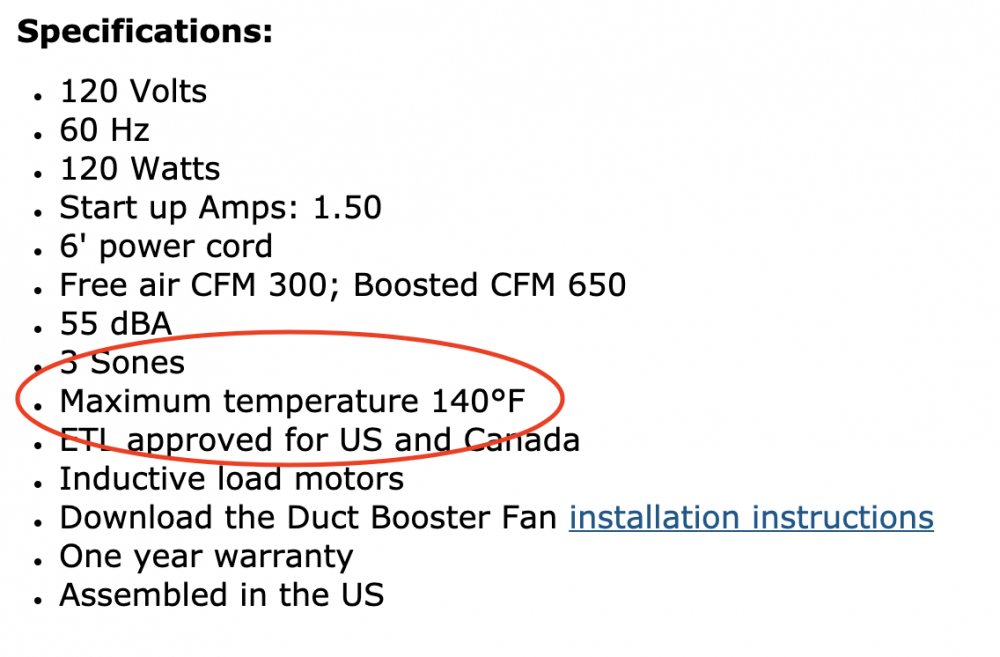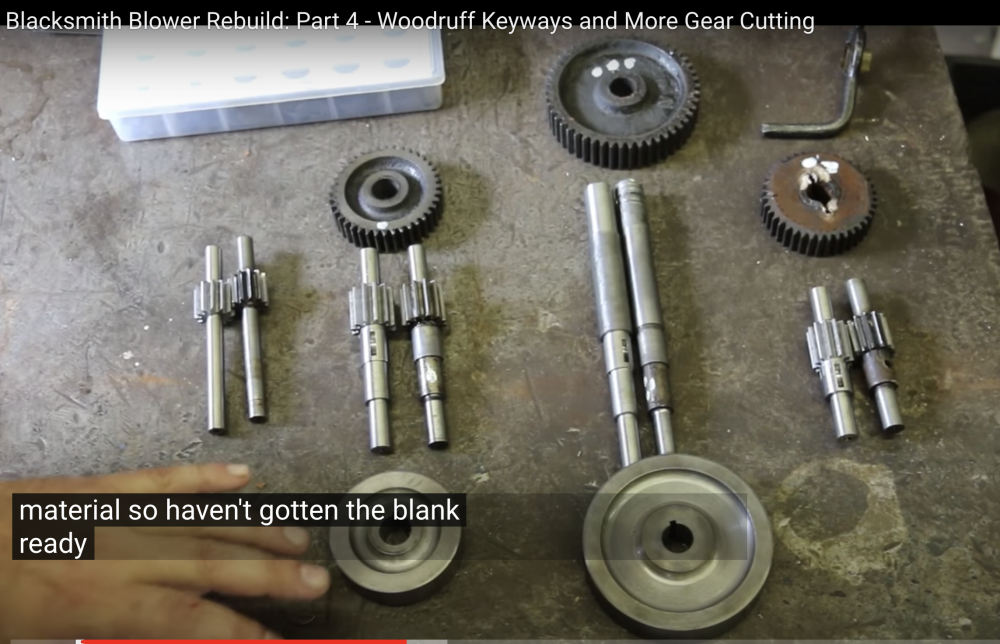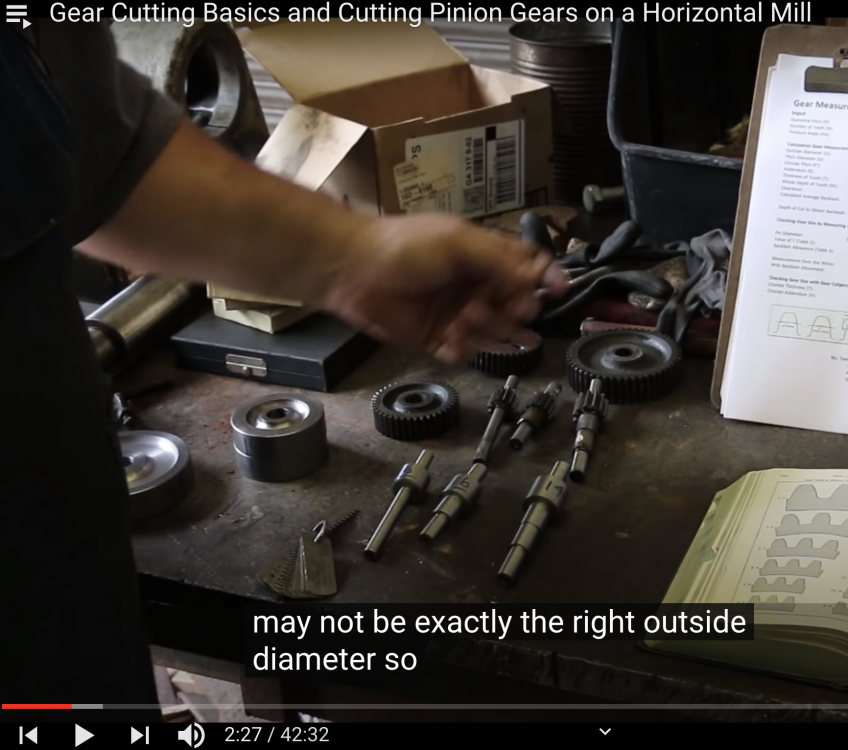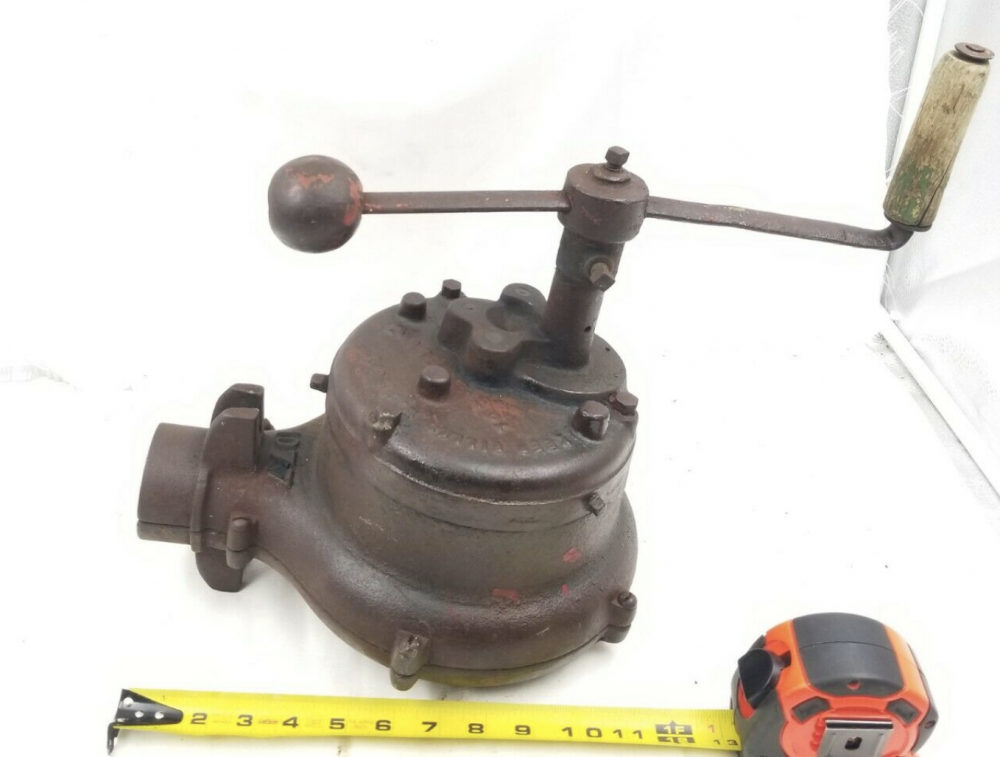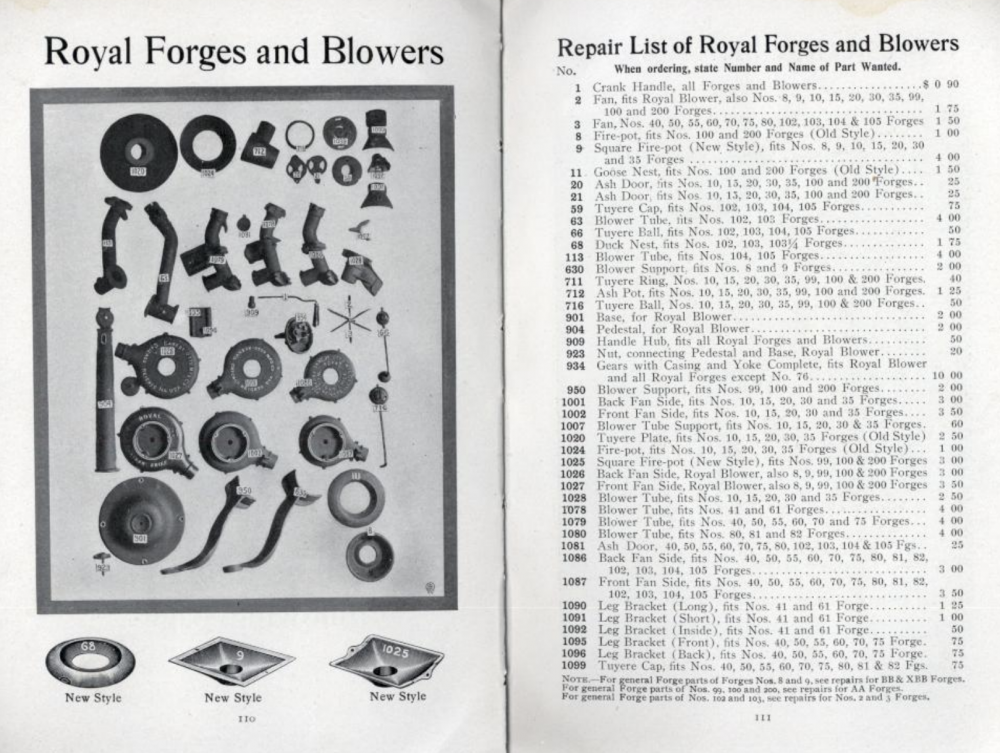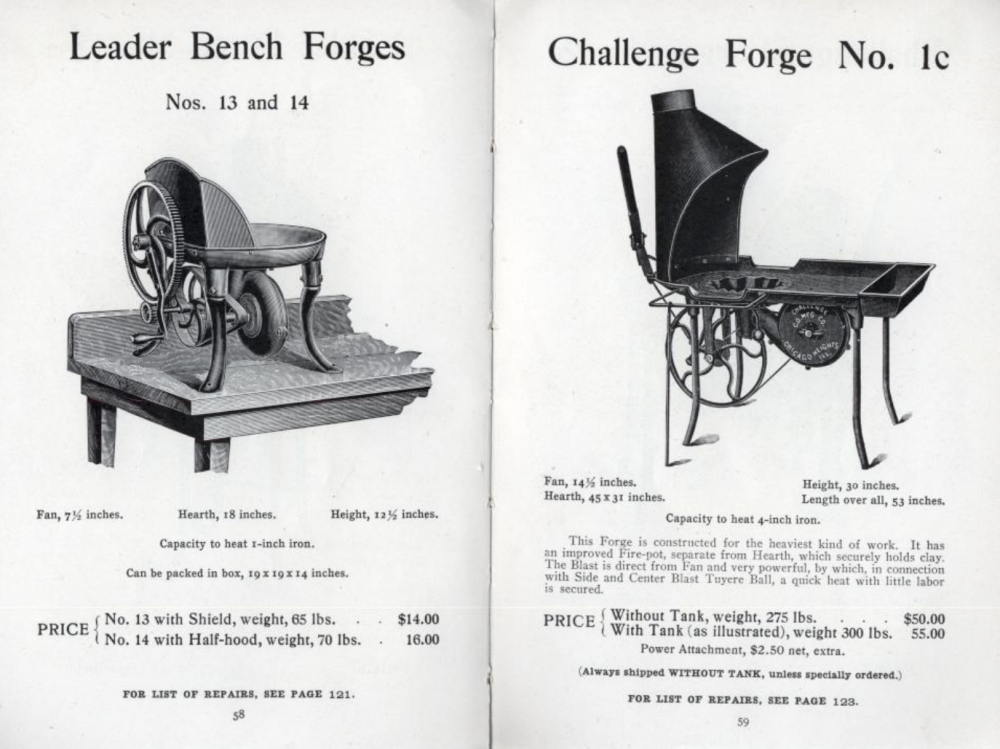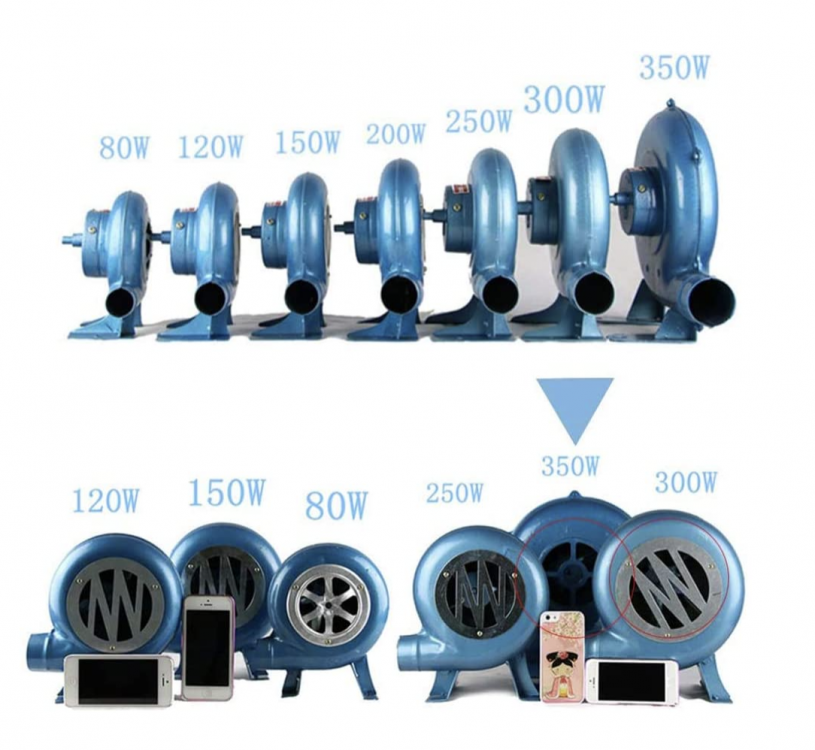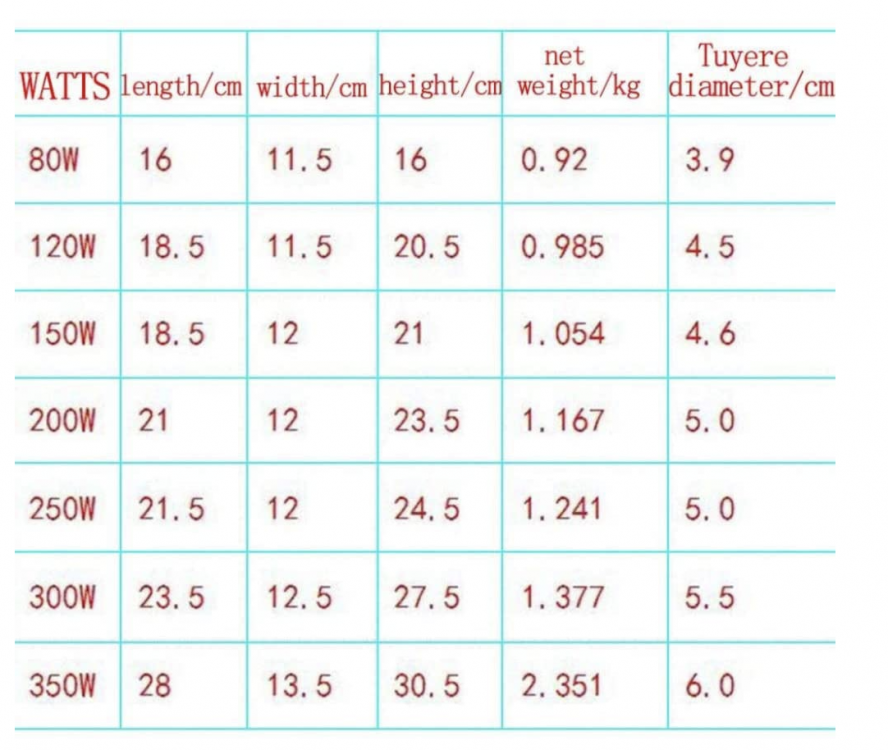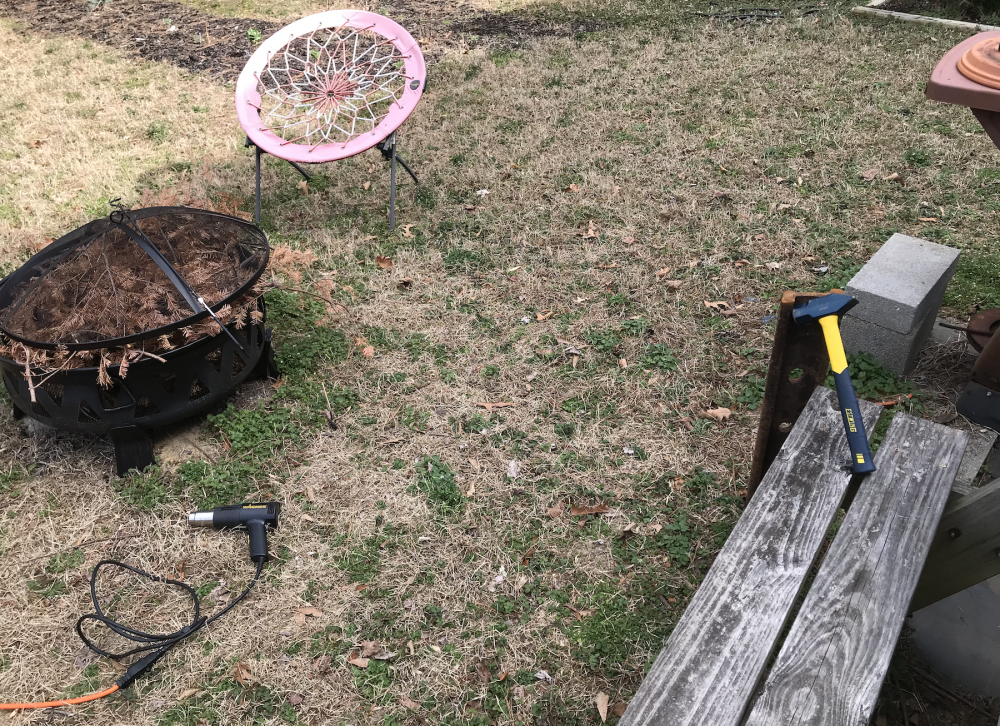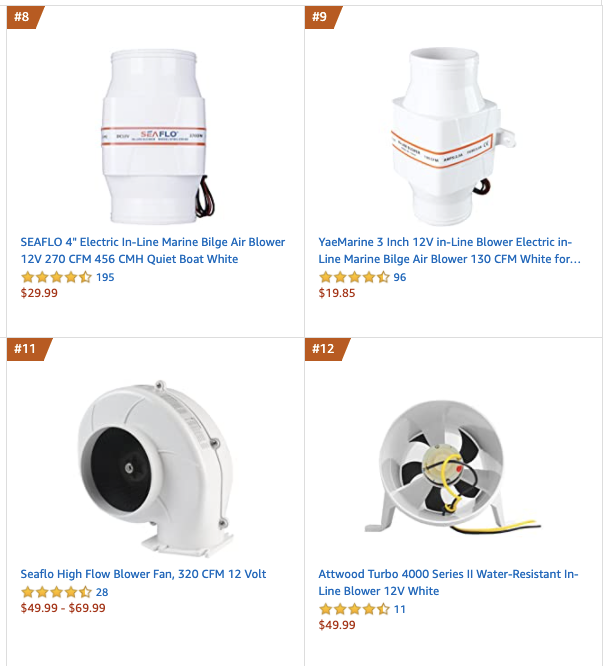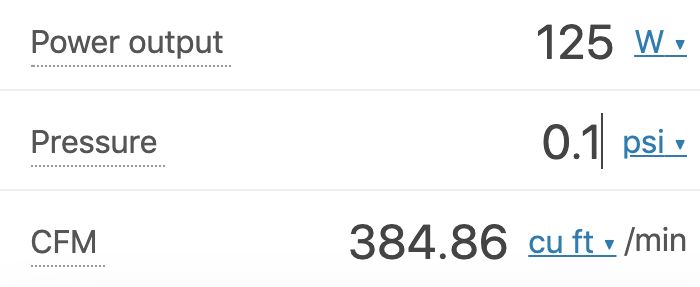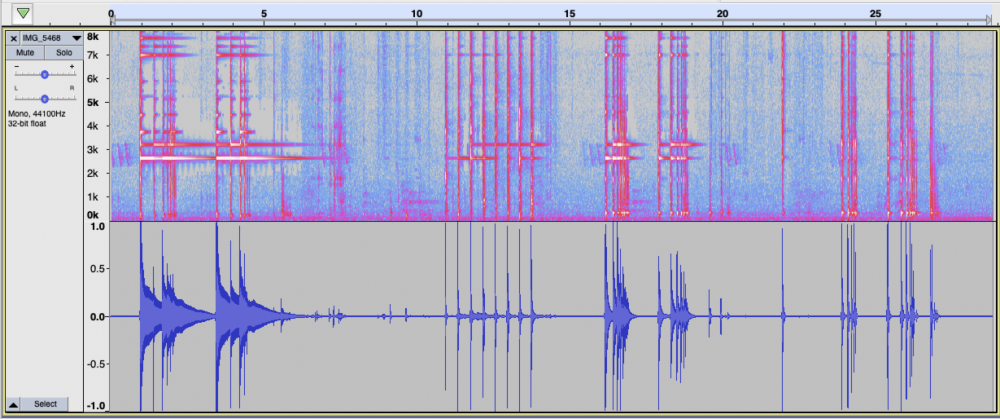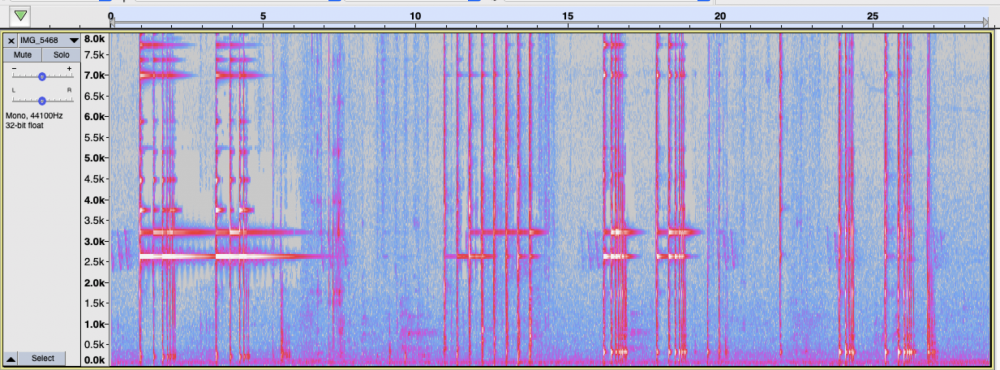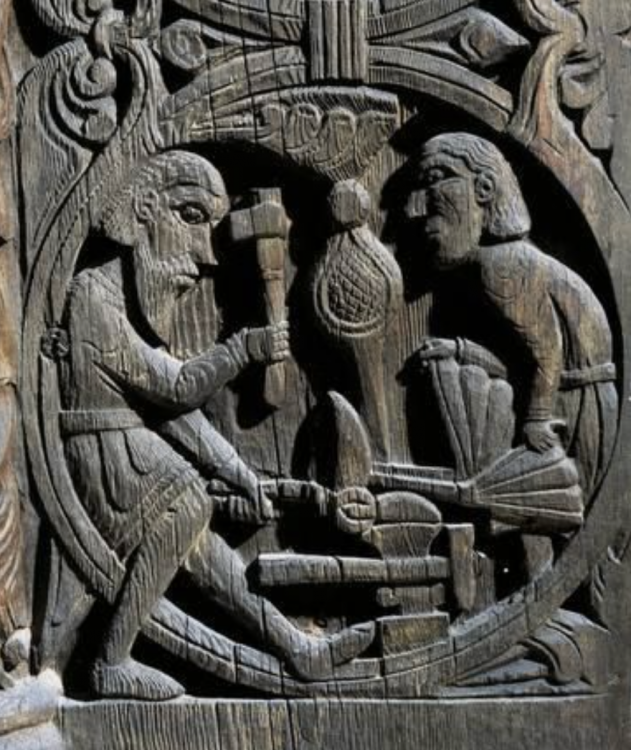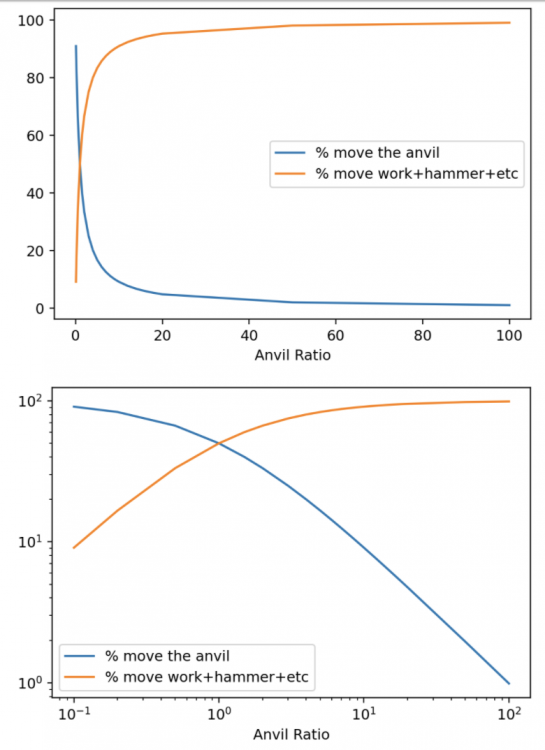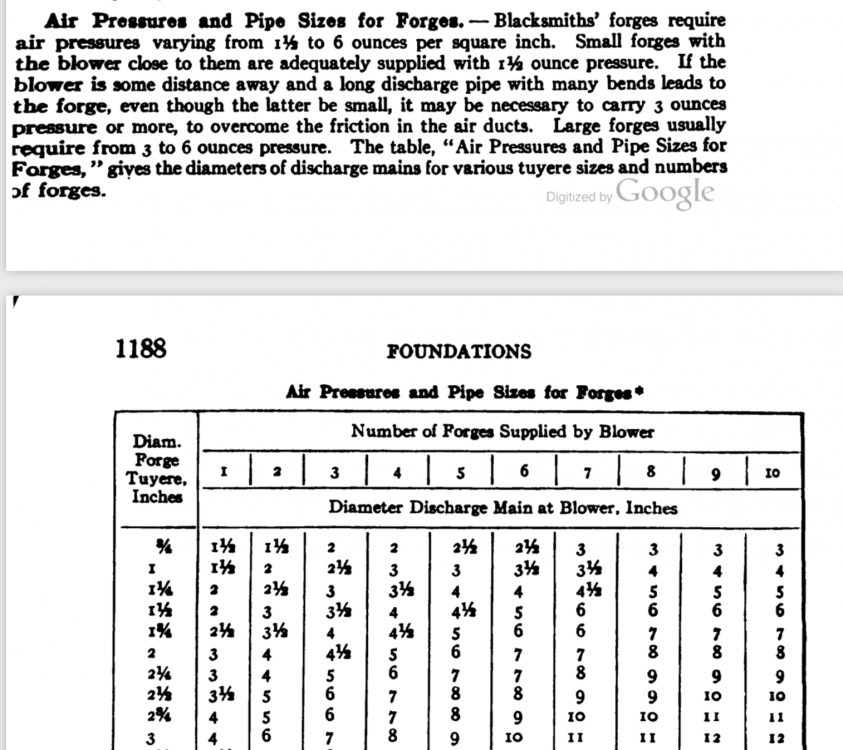
Dave F
Members-
Posts
33 -
Joined
-
Last visited
Content Type
Profiles
Forums
Articles
Gallery
Downloads
Events
Everything posted by Dave F
-
-
Per those amazing videos, the Canedy-Otto gear train is 50 tooth 16DP : 12 tooth 16DP shaft shared with a 40 tooth 14DP : 12 tooth 14DP shaft shared with a 40 tooth 16DP : 12 tooth 16DP output shaft. So overall, the speed increase is 50/12 * 40/12 * 40/12 = 46.25:1
-
What did you do in the shop today?
Dave F replied to Mark Ling's topic in Blacksmithing, General Discussion
All I did in the shop today was put dirt in a box. https://www.iforgeiron.com/forum/267-jabod-just-a-box-of-dirt/ -
Out of the blue Ebay just Unsolicited Commercial Emailed me the listing on this one. I'd guess it's a ~7.5" fan. Based on the 1077 and 1076 in the pics, and this spare-parts page from that catalog, I'd bet an S-hook that it's a tinier-than-normal Canedy-Otto.
-
As you said, it's hard to tell the size from pictures. Can you measure something on it and say how big it is? From a Canedy-Otto catalog at http://www.bamsite.org/books/canedy.pdf their normal fan size is 10-12". Theydo show some lighter weight ones going down to 7.5" with "Capacity to heat 1-inch iron", and heavier ones going up to 14.5" with "Capacity to heat 4-inch iron". For their 10" fans they say has capacity to heat 3-1/2" iron. How big is tiny?
-
How tiny is tiny? If that's a 3" outlet, the pivot bolt head is about 1/2", the hub is about 1", the pipe is about 2", and the diameter is about 10". Is that about right? That would be huge compared to the new 6" tall "80W hand crank" blowers sold for BBQ grills on Amazon.
-
The David Gingery book on "How to Design & Build Centrifugal Fans for the Home Shop" is very interesting. It talks about the relation between CFM and pressure, how the rpm and diameter turn into surface speed and limits the max velocity and CFM through the outlet, how to shape the ducts with the same 12 degree taper limit Frosty talks about, how to measure the pressures and speeds, etc.. The whole Gingery series is great. Larger input watts driving a larger 9" wheel will get you more CFM out. The sharp bending in the flow from circumferential flow to axial might slow things a bit, but this is designed to be an in-line vent booster. If you need more air out of it, take a look at the Gingery book and consider modifying it to pick up the flow from the circumference. pnut: Regarding undersized blowers, I saw a pretty good picture of the range of the imported hand crank blowers. The 1# blower looks a heck of a lot wimpier than the 5# blower.
-
Frazer, I'm not measuring or computing backpressure, I'm choosing the top end of the 0.1-0.4psi range of forge backpressures from the old Machinery's Handbook pages, where it looks like they are talking of the junction into the forge, then I over-optimistically assume 100% efficiency in converting the electrical power into air power. Once you de-rate the blower down into it's actual operating envelope, then the pressure vs. flow tradeoff is pretty much P1 * V1 = P2*V2 -- If the clinkers double the pressure, they'll halve the flow. I'm planning on my 25yo "Aussie Folding Grill" as the B for a JABOD. pnut, a year outside is pretty good for particle board. My family was in the particle board industry since the 40s. We used it for everything and turned lots of it back into sawdust.
-
Cool setup pnut--It's nice to see systems that look like a practical, achievable step up from mine. On the stump is that a vise, bending jig, guillotine tool, or something else? Don't laugh, but here is a picture of my improvised picnic-table, firepit, hot-air gun, RR fishplate-stuck-in-the-dirt setup. The soft fishplate works a little better when I grind it flat, but I really wanted more space. JBOD is next. My whiney Coleman AC Mattress blower is 170W. That looks like overkill relative to a 1/6HP furnace blower or Champion 400. I'll try it out. With the air-horsepower link removed above, the conversions between PSI, CFM, and power is this constant: 1 HP = 745.7W = 100psi * 2.296 CFM (or 1 CFM = 745.7W / 229.6psi or 1 CFM = 3.248 W/psi ) So for my 170W blower at 0.4psi back pressure and 100% efficiency, maximum ideal CFM is: 170 W * 1 CFM/(3.248 W/psi) / 0.4psi = 130 CFM
-
Last fall I was experimenting with the end of a railroad fishplate as an anvil, a firepit with wood as a forge, and a handheld AC heatgun as the blower. I could get to some kind of orange, but the whole setup was pretty awkward. Even though that DC fan specs 213CFM, with only 22.8w power input, its output flow at forging pressures might be something like 1/4 of what a Champion 400 hand-crank blower might push. I have battery and an AC air mattress inflators and they both whine so loud I can't imagine listening to them for longer than a mattress fill. Last year I was using an old bathroom blower for drying out a waterlogged sunfish hull, but it died. I thought about a marine blower like one of these below, but I found that the ~1CFM natural flow from a black ABS corrugated drainpipe as a chimney worked pretty well for the humidity-extracting purpose. The $50 12V marine blower from Amazon looks like it might be 60W, but that still might deliver only a fraction of what a hand crank puts out. Then I thought a junkyard automotive heater fan might be a good GTTS solution for a quiet 12V blower, but it's hard to see the specs. We've been living like hermits under COVID, so I haven't been able to go scrounging for my hobbies.
-
I came to this thread wondering about the sizing of a blower, and it looks like the answers are all is that rather than CFM, you need an adequate pressure vs CFM balance, and psi * CFM converts into watts. I've got an oversized solar panel for lawn tractor battery maintenance, so I can get some 12V power out of my shed a bit easier than 120V, and I was curious about what sort of blower I could use. A cheap 24W or 65W motorboat inboard engine blower seems a bit undersized, but maybe there's a 10-15A car heater fan I can get from the junkyard.
-
With this ... and several of the other refs on the thread, a 1/6hp or 125W furnace blower seems adequate. Ignoring efficiency and using the calculator at link removed with the various pressures on the thread, that 125W gives CFMs of: 13 CFM at 3psi /48 ozf/in2 / 20kPa 38 CFM at 1psi / 16 ozf/in2 / 6.9kPa 96 CFM at 0.4psi / 6 ozf/in2 / 2.8kPa 384 CFM at 0.1 psi / 1.5 ozf/in2 / 0.690 kPa I might look for a 125W 12V furnace blower for the solar panel by my shed.
-
Anvil stand mass and stiffness
Dave F replied to Dave F's topic in Stands for Anvils, Swage Blocks, etc
If you wanted to get fancy, you could firm it up using steel for the dovetails and wedge. I was thinking a couple RR spikes could work to capture one end of the base and leave the hardy hole more open, but the 2x6s were handy and easy to try. -
Anvil stand mass and stiffness
Dave F replied to Dave F's topic in Stands for Anvils, Swage Blocks, etc
BartW: Yeah, mass on the horns do a lot for noise. I was surprised how much just gripping a horn in a fist quieted the ring. Twigg: I tapped near the center of the face. It was a spectrogram of the audio track from the iPhone video posted on Youtube. The entire documentation of my data collection procedure is contained within the video. Since it's somewhat awkward to extract the data from Youtube, I attached an MP3 file of the audio data. I opened the video file with Audacity audio editor (free from https://www.audacityteam.org/ ) and clicked the Track's downward-triangle to choose "Spectrogram". One could also use Audacity's Analyse/Plot Spectrum tool, but the spectrogram gave a pretty decent overview. I just noticed that the "MultiView" option is cooler: IMG_5468.mp3 -
Anvil stand mass and stiffness
Dave F replied to Dave F's topic in Stands for Anvils, Swage Blocks, etc
Which premise is wrong? I'm trying to say that the energy you lose to a real-sized anvil & stand has to be bound between the real-sized anvil free-floating in space and a perfect, earth-sized anvil, and that any losses at the changes of material between the anvil and the stand, the stand and the earth, or to the cruddy materials the stand is made out of, or the soft, peaty earth under my log, all must fit within those bounds. Those losses at every change of material are the elasticity and ductility of the material, and the impedance mismatches between the differences in densities and propagation speeds at the interfaces. The quality of those connections are measured in well they reflect, transmit, or transform energy. The instantaneousness of the impact depends on the ductility (and elasticity) of the work. You can measure the force-time impulse with expensive sensors, but the quick & dirty way is to divide the depth of the deformation by speed of the hammer per-impact--If you let a hammer drop 1 meter onto your yellow heat steel, it will be going 8.85m/s, if it makes a 1mm deep divot, the impact took ~0.001m/(8.85m/s)=0.113ms. The shallower the divot, the faster the impact (at zero depth, it's how long it takes to compress your elastic hammer or anvil like a spring). I used a premise of 0% rebound, as if I hit a chunk of sticky, soft lead, doing the maximum possible about of work to the workpiece, to focus on the energy that is transferred into the anvil system. Using those premises, doing the physics 101 inelastic collision math reproduced the result that a 40:1 anvil:hammer ratio is pretty good, and puts numbers to just how good it is (97.6%) relative to heavier or lighter ratios. The first is well known, but the I thought the second was pretty interesting: This measure of anvil efficiency is basically 1-hammer_mass/(hammer_mass+anvil_mass) You can get some extra anvil_mass credit for better support, and a 150# dead, delaminated anvil might work like a 10# anvil poorly coupled to a 140# base. I'm not claiming that the sound energy propagating down through the steel, stand, earth, and bedrock will rebound back up to deform the workpiece, I'm claiming that depending on the size of the anvil, there's limits on how big the losses between the anvil & stand and between the stand & earth, and how much stand improvements or any possible voodoo can make an anvil "work" like a bigger anvil. If you think my tables and graphs should bend differently because I've got the premises wrong, please tell me. ## There's other important criteria for stands, like portability, noise, stability, immobility, maintainability, functionality, and carvings. Noise-wise, I might experiment with caulk, but I think this double-horn Acciaio might be shaped like a tuning fork, and improved holding of the handle of the tuning fork might not solve it. Here's a time-spectrogram of my movie above, (using "Audacity") showing the frequencies of the paired taps on the loose, wedged, and magnet-ized anvil. -
Anvil stand mass and stiffness
Dave F replied to Dave F's topic in Stands for Anvils, Swage Blocks, etc
I'd bet that the hammer face detached--I'm sure the woodcarver has handled a hammer before, and maybe even had his chisels forged. I like the two-handed double bellows. -
Anvil stand mass and stiffness
Dave F replied to Dave F's topic in Stands for Anvils, Swage Blocks, etc
Check my premise? It's springs all the way down--solids, from diamond, through steel, concrete, wood, rammed earth, bedrock, wood, silicone caulk, all have elastic coefficients. The energy that propagates far (2 meters?) into the earth due to movement won't be return in time to deform the workpiece. My assuming a negligible hobby-horse spring suspension as the worst possible stand gives an upper bound on how much better a better stand could be. The other bound is the zero kinetic energy in a perfectly solid, mass-of-the-earth, zero-movement, anvil+stand. The space between those two bounds is the kinetic energy lost due to the anvil moving due to any motion or springiness in the anvil+mount. Impact-wise, if you set a 300# anvil on a platform with 300 1# springs and hit a workpiece with a 1# hammer, it can't perform more than 0.33% worse than if you cast the base directly into 1,000 tons of cast iron. If your mount is better than some negligible springs, you get extra credit for the extra mass effectively coupled to your anvil. The cast base will perform better, but there really isn't much energy that can make it through a heavy anvil into a stand. For a light anvil, a good base could make a huge improvement. You could neglect that materials act like springs and dampers, but as you get down into paying money, time and effort for improvements, the material properties may begin to matter. At the light end of things, couplings and support materials might matter much more than at the heavy ratios, like how one might hold up a rivet dolly against a 1# hammer, versus a monster anvil sitting on a shop floor. -- looks like a stake anvil in a log steadied by a foot. A good log probably matters there. -
Anvil stand mass and stiffness
Dave F replied to Dave F's topic in Stands for Anvils, Swage Blocks, etc
Aw, overthinking it this way puts bounds on how much time to waste doing things. How about a picture or two: The bigger the anvil:hammer ratio, the less energy goes into moving the anvil and more goes into moving the work. Up past 40:1, a bigger anvil (or stand that adds to the responsive mass of the anvil) works on the last 2.4%. Now I should quit and start working on the bands, or better, a forge or, a roof over the stump. -
Anvil stand mass and stiffness
Dave F replied to Dave F's topic in Stands for Anvils, Swage Blocks, etc
Overthinking things, here's a table of hammer:anvil ratios, and, assuming your anvil is mounted on soft springs, and a clay-like workpiece deforms and absorbs all the energy it can to decelerate the hammer and accelerate the anvil into a perfectly inelastic collision: Anvil eff eff ratio work non-work 1:1 50.00% 50.00% 2:1 66.67% 33.33% 5:1 83.33% 16.67% 10:1 90.91% 9.09% 15:1 93.75% 6.25% 20:1 95.24% 4.76% 30:1 96.77% 3.23% 40:1 97.56% 2.44% 50:1 98.04% 1.96% 60:1 98.36% 1.64% 70:1 98.59% 1.41% 80:1 98.77% 1.23% 90:1 98.90% 1.10% 100:1 99.01% 0.99% 120:1 99.17% 0.83% 140:1 99.29% 0.71% 160:1 99.38% 0.62% 180:1 99.45% 0.55% 200:1 99.50% 0.50% 500:1 99.80% 0.20% 1000:1 99.90% 0.10% The lost non-work% (the motion of the anvil into the springs) is the energy that is available to be recovered by a better, stiffer stand. Elasticities in the hammer, anvil, or workpiece would come out of the effective work % assumed to deform the workpiece, and that loss would end up as kinetic energy in rebound, or noise. It's interesting to think that the colder and more elastic the work is, less deformation and more rebound will happen--at 40:1, you could easily lose more energy to bouncing off cold material than to a sloppy stand. Frosty, yes, it seems like rapidly diminishing returns above 20:1 or 40:1. The mass of a stand can add to the effective mass of an anvil, but only if it is stiff enough to return the energy back into the workpiece while it is still being deformed. 500# of soft springs might eventually return the anvil to position, but they won't be fast enough to do useful work during the ~0.0005s the hammer is deforming the steel. Steel bolted to the anvil would add mass, but maybe a sand filled leg or box would add mostly sound damping and stability. Noise-wise, clamping the anvil well can change the natural frequency, and the coupled stand can also dampen the vibrations. There's probably complicated frequency-dependent impedance matching issues at the interfaces between anvil, stand, and floor if they are different materials. BsnNFrnt Stability-wise, I was first worried about moving around or safety from falling over. I can see that real immobility can be good for more than that. -
What's the round hole called on a German and other European anvils? I've got an Italian-pattern Acciaio and the round hole is in the horn, stepped about 5mm down from the face & really doesn't seem like it would give good full-circle support for punching. It seems best used for hold-down, but maybe with the step it would help keep a round-shanked hardy oriented.
-
Anvil stand mass and stiffness
Dave F replied to Dave F's topic in Stands for Anvils, Swage Blocks, etc
Pushing forward to good-enough, here's my 66 lb Acciaio anvil on a 130# Cherry stump. Sitting free, it hurts my ears. Wedged down, it quiets a bit. Adding magnets, the ring is mostly a click: At 20:1 anvil:hammer weights, (with lots of simplifying assumptions, like a perfectly inelastic collision where the work's deformation absorbs all of the rebound, and the anvil floats free in space and doesn't pass any energy on to anything else) the energy after the collision is only 4.5% for noise, wobbling and everything else. With my 2.5# hammer vs a 66#, it's 3.7% leftover, 40:1 would be 2.4%, 80:1 would be 1.2%, 100:1 would be 1%. If my stump-wedge setup acts like 130# of steel perfectly welded to the bottom of my anvil, the best I'd possibly get is 99.42% I'm sure I'm not skilled or conditioned enough to notice a 3% difference lost, so I think it's good enough for now. I think I like my wedge setup -- I can tighten it with a tap, and break it down with just my hammer and put the anvil into the shed in less than a minute. The only trick is to cut the wedge first, and use it to mount the 2nd dovetail. -
The 1914 Machinery's Handbook has some design info for the pressures-- 1.5-6 oz per square inch, times (1lbf/16ozf * 27.7inH2O/psi) = 2.6-10.4 in-H2O.
-
JLP Blacksmith Teaching Center.
Dave F replied to jlpservicesinc's topic in Building, Designing a Shop
The air has to go somewhere. Maybe after a while the fuel vapor can displace some of the air and pushes the excess vapor out through the filter outlet. -
Anvil stand mass and stiffness
Dave F replied to Dave F's topic in Stands for Anvils, Swage Blocks, etc
Yeah, I was thinking about the way that "mass", "resonance", and "working" are different issues. Epoxy deadened your ring, but you have the same mass. Did epoxying make any other difference than the ring? Resonance-wise, I have a shiny #66 Acciao anvil and it rings brightly. Geeking out like an engineer, I worked out the natural frequency of a similarly-sized steel beam (https://www.engineeringtoolbox.com/structures-vibration-frequency-d_1989.html ) and it doesn't seem too far off from the tone. I can quench the ringing with a magnet, gripping a horn in a fist, clamp, a plumbing T, or jamming a chunk of 2x4 over it. I also clamped the base to a flimsy bit of 3/8" plywood with some wood clamps, and that also quiets the ring somewhat. Setting it in a bed of sandy dirt on the ground didn't seem to do too much to the ring. Joey's tiny anvil was moving around under the clamps with each hit--A small anvil might "work" for a short job, but people really seem to think the big ones are worth it. Would a 66# anvil epoxied to a 66# box of sand work like a 132# anvil on a stool?
